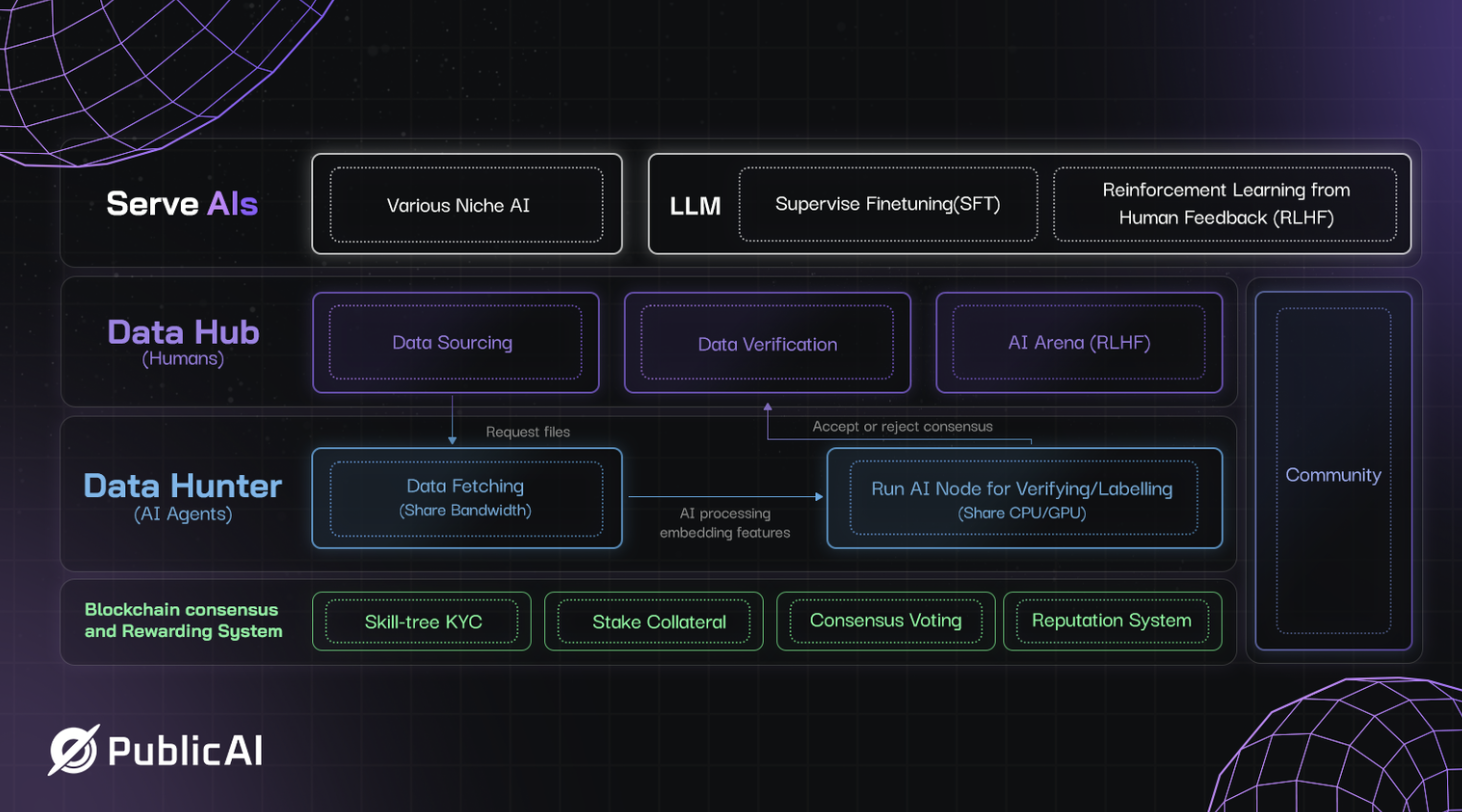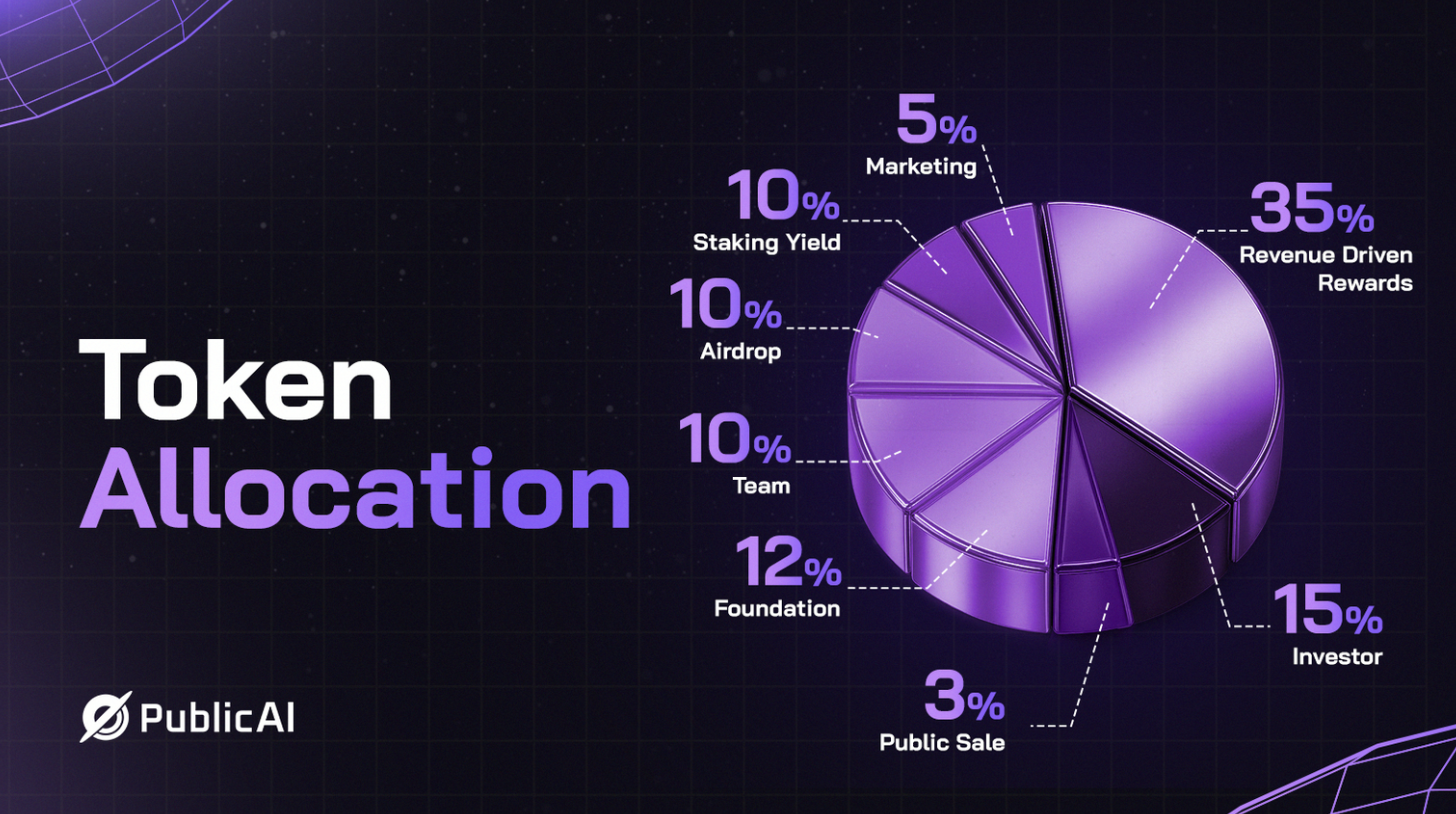What is PublicAI (PUBLIC)?
What is PublicAI?

(Source: docs.publicai)
PublicAI is a decentralized platform built around human expertise and judgment, designed to create the Human Layer for AI. Rather than simply being influenced by AI, individuals can become active participants and beneficiaries in the AI ecosystem through PublicAI.
PublicAI Core Philosophy
PublicAI’s mission is to empower people around the world to participate in the AI economy with their skills and expertise—regardless of location, allowing them to turn those skills into tangible value. PublicAI accomplishes this through a three-tiered architecture:
Layer 1: DataHub — Decentralized Data Hub
DataHub serves as PublicAI’s main platform for data collection and verification. DataHub sources and ensures the quality of AI training data.
Data Collection Tasks: Initiates various data-driven campaigns, inviting contributors to submit datasets according to project requirements.
Voting-Based Validation: Community members vote to verify whether submitted data meets set criteria, establishing consensus and guaranteeing data quality.
Incentive Mechanism: Contributors who upload high-quality data and community validators can earn USDT and $PUBLIC airdrop rewards, with rewards based on alignment with community consensus.
This layer gathers diverse, authentic, and high-quality AI training data from around the globe, avoiding bias and limitations associated with single-source inputs.
Layer 2: Data Hunter — Bridging Nodes and AI Interaction
Data Hunter focuses on node operations and AI interaction, enabling node operators to provide computational power and data processing for AI applications.
Node Operations: Leveraging Data Hunter, node operators can deploy AI agents to assist DataHub in improving data validation efficiency.
AI Community Engagement: Nodes can utilize the AI-powered reply feature to generate AI-driven responses to trending posts on X (formerly Twitter) with over 1,000 views, producing high-value AI feedback data.
Revenue Model: Node operators earn $PUBLIC airdrop rewards both by providing computational resources and through active engagement in AI communities.
This layer transforms the community’s role from passive data contributors to active, real-time participants in an ongoing AI ecosystem via node-AI collaboration.
Layer 3: Blockchain & Smart Contracts — Foundation for Trust and Transparency
At its core, PublicAI relies on blockchain to guarantee the security, transparency, and traceability of both data contributions and reward allocations.
BFT Consensus: Decentralized voting confirms data quality and prevents malicious activity.
Rewards & Penalties: The protocol rewards outstanding contributors and automatically penalizes malicious actors.
Governance: The community can participate in protocol development, influencing platform rules and market directions.
This layer ensures transparency across the entire ecosystem and sustains trust through immutable records on-chain.

(Source: docs.publicai)
Value and Opportunity of the Human Layer
PublicAI goes beyond data collection, placing a strong emphasis on human involvement in the AI inference stage. When AI is faced with real-world decision-making, humans step in to review, guide, and adjust AI outputs in real time. This approach empowers workers displaced by AI to transition into higher-value roles. They shift from simple task execution to becoming AI quality assurance professionals and decision support partners.
PublicAI Tokenomics
$PUBLIC is PublicAI’s native utility token, capped at 1 billion in total supply. It underpins governance, incentives, staking, and access to platform features. The token economic model is centered on income-driven issuance. Actual platform revenue drives token circulation, rather than relying solely on inflation or speculation.
Token Distribution
1. Community Rewards (35% / 350 million): The largest share goes directly to contributors of AI training data, with tokens issued proportionally to real platform revenue, building a sustainable reward structure.
2. Community Distribution (20% / 200 million):
- Airdrops: Targeted at early users, DataBabies NFT holders, and top contributors in DataHub and Data Hunter with high engagement scores.
- Staking Rewards: Includes liquidity incentives, long-term holding bonuses, and earnings for DAO participation.
3. Investor Support (15% / 150 million): Allocated to early investors (VCs and angels) as compensation for funding platform development.
4. Public Sale (3% / 30 million): Open to global buyers, expanding the token holder base.
5. Foundation Reserve (12% / 120 million): Managed by the foundation for ecosystem grants, research, partnerships, and operational reserves.
6. Core Operations (15% / 150 million):
- Team (10%): Incentivizes core team members for long-term commitment and contributions.
- Marketing (5%): Supports brand promotion, market expansion, and exchange listings.

(Source: docs.publicai)
This distribution model puts the community at the heart of project success while securing stable capital for ongoing development and operations.
BFT Two-Stage Data Validation
PublicAI implements a two-stage validation process to guarantee data quality:
AI Screening: Submitted datasets are preliminarily filtered by AI agents, reducing manual validation costs.
Human Voting: Three roles—Scout, Guardian, and Judge—vote to audit the data. If any part is found faulty, the entire dataset is rejected, ensuring the highest quality standards.
Development Roadmap
2025 Q3: Launch DataBabies NFT and initiate airdrops; complete mainnet token contract audits; TGE and exchange listing.
2025 Q4: Start PublicDAO governance and token distribution voting; roll out the buyback program and HeadCap DePIN presale.
2026 Q1: Introduce HeadCap EEG contributors; expand enterprise data activity engines and API tools; begin commercialization of deepfake and robotics data.
Want to discover more about Web3? Sign up at: https://www.gate.com/
Summary
PublicAI is creating a decentralized, human-centric AI ecosystem where users worldwide can transform their knowledge and skills into real economic value. By leveraging a three-layer architecture and a revenue-driven token model, PublicAI delivers high-quality, unbiased data for AI and opens up new career and income opportunities for people in the age of AI.
Related Articles

Pi Coin Transaction Guide: How to Transfer to Gate.io

What is N2: An AI-Driven Layer 2 Solution

Grok AI, GrokCoin & Grok: the Hype and Reality

How to Sell Pi Coin: A Beginner's Guide

Crypto Trends in 2025
